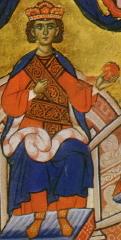Henry II of Cyprus facts for kids
Quick facts for kids Henry II |
|
|---|---|

Silver 'gros grand' coin issued in the reign of Henry II. This silver coin replaced older ones and showed a king on his throne in a Western style.
|
|
| King of Jerusalem and Cyprus | |
| Reign | 1285–1324 |
| Predecessor | John II/I |
| Successor | Hugh IV/II |
| Born | June 1270 |
| Died | 31 March 1324 (aged 53) Strovolos, Cyprus |
| Spouse | Constance of Sicily |
| House | Poitiers-Lusignan |
| Father | Hugh III of Cyprus |
| Mother | Isabella of Ibelin |
Henry II (born June 1270 – died 31 March 1324) was an important king in the late 1200s and early 1300s. He was the last person to be crowned King of Jerusalem. After the city of Acre fell in 1291, this title became mostly symbolic. Henry also ruled as King of Cyprus. He belonged to the Lusignan family, a powerful noble house.
Contents
Becoming King
Henry was the second son of Hugh III of Cyprus. He became king on May 20, 1285, after his brother John I passed away. He was crowned in Santa Sophia in Nicosia, Cyprus, on June 24, 1285.
Reclaiming Acre
At the time, Charles of Anjou was trying to claim the throne of Jerusalem. But Charles died in 1285, which helped Henry. Henry quickly gathered a fleet and attacked Acre, a very important city. Acre was defended by Charles's officer, Hugh Pelerin. Henry's forces captured the city on July 29, 1285.
Henry was then crowned King of Jerusalem in Acre on August 15, 1286. After his coronation, he went back to Cyprus. He left his uncle, Philip of Ibelin, in charge of Acre as a Bailiff.
Losing the Holy Land
By this time, Acre was one of the last remaining coastal cities held by the Kingdom of Jerusalem. During Henry's rule, the Mameluks, a powerful Muslim empire, captured more cities. They took Tyre, Beirut, and other areas. They also destroyed the County of Tripoli in 1289.
The final siege of Acre began on April 5, 1291. King Henry was present in the city during this terrible battle. He managed to escape to Cyprus with many of his nobles. The city of Acre then fell to Khalil on May 28, 1291. This event marked the end of the Crusader states in the Holy Land.
Ruling Cyprus
Even though he lost Jerusalem, Henry continued to rule as King of Cyprus. He still claimed the title of King of Jerusalem and often made plans to try and get the Holy Land back.
Plans for Recovery
Henry tried several ways to recover the lost territories. In 1299 and 1300, he tried to work with Ghazan, the Mongol ruler of Persia. Ghazan invaded Mameluk lands in 1299, and Henry hoped to join forces with him. Henry also tried to stop ships from Genoa (an Italian city) from trading with the Mameluks. He hoped this would weaken them economically. He even wrote to Pope Clement V twice, asking for a new crusade to reclaim the Holy Land.
Prosperous Reign
Henry's time as king in Cyprus was very successful and wealthy. He was deeply involved in the justice system and how the kingdom was run. He made sure that the Haute Cour (the high court) started keeping written records for the first time. These records were written in Italian or French, not Latin. He also made the court more powerful, changing it from just an advisory group to a real court that tried and punished criminals.
However, Cyprus was a small island kingdom. It was not strong enough to help Henry achieve his biggest dream: getting the Holy Land back.
Challenges and Exile
Henry faced some health challenges that sometimes made it difficult for him to rule. His nobles were not always happy with him. In 1303, he had his brother Guy, who was the Constable of Cyprus, put to death. This was because Guy was accused of plotting against him.
In 1306, another brother, Amalric, Lord of Tyre, who was the Constable of Jerusalem, worked with the Templars to remove Henry from power. Amalric took the title of Governor and Regent of Cyprus, not King. Henry was removed from his throne on April 26, 1306. He was sent away to Armenia, where King Oshin of Armenia was Amalric's brother-in-law.
Return to Power
However, Amalric was murdered in 1310. After this, King Oshin of Armenia released Henry. Henry returned to Cyprus and took back his throne on August 26, 1310. He had the help of the Hospitallers, another powerful knightly order. When he returned, he imprisoned many people who had conspired with Amalric. This included their brother Aimery and other relatives.
In 1313, Henry oversaw the end of the Templars in Cyprus. Their property was then given to the Hospitallers.
Later Life and Legacy
Henry married Constance of Sicily. She was the daughter of Frederick III of Sicily. They married in Santa Sophia, Nicosia, on October 16, 1317. They did not have any children. Constance later married two other important figures.
King Henry II died on March 31, 1324, at his home in Strovolos, near Nicosia. He was buried at the Franciscan Church of Nicosia. His nephew, Hugh IV, became the next king.


